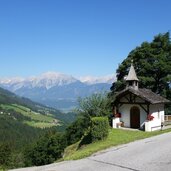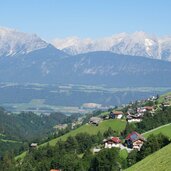Once upon a time, Weer was a centre for gold panning - today, however, the Saint Gall Rococo Church is particularly worth a visit
Image gallery: Weer
Altitude: 558 m a.s.l.
Weer extends on a detritic cone of the Weerbach river, below the village of Weerberg. The Illyrians and afterwards the Romans settled this area, which is testified by many old field names, followed by the Baiovarii. Like its surroundings, also Weer flourished in the 16th century, when mining in Schwaz was at its climax. Furthermore, out of the sand of the Weerbach river gold was panned.
The most famous sight of Weer is the St. Gall Church, one of the most astonishing Rococo churches of Tyrol. The ceiling paintings from 1779 AD are masterpieces of the famous Tyrolean painter Anton Zeiller. Beside the fabulous peaks of the Karwendel Mountains, the Weisslahn bathing lake in Terfens, 3 km away, attract lots of people. There's also the "Upside Down House". Another way of experiencing the landscape is a horseback ride at the well-known Weererwirt.
In winter, however, Weer offers cross-country ski tracks and several toboggan runs in the surroundings. Only a few-minutes' car drive away, there are the famous skiing areas of the Silver Region Karwendel, such as the Kellerjoch Skiing Area featuring 14 km of ski slopes, and of Innsbruck and surroundings: The Alpine City is only 20 km away.





























